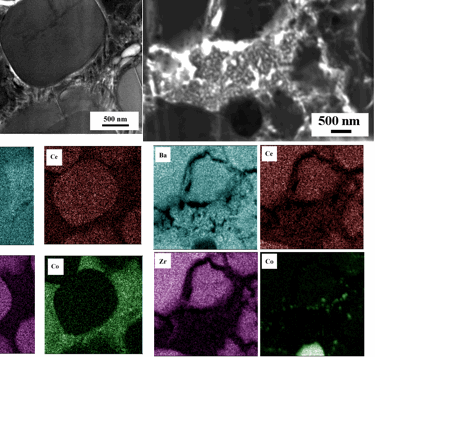AmericanChemicalSociety.com
Reports: DNI10 49007-DNI10: Electroceramic Materials for High-Purity Hydrogen Extraction from Liquid Hydrocarbon Fuels: Fundamental Investigations of Coupled Electrochemical and Catalytic Phenomena
Benjamin A. Wilhite, University of Connecticut
Cobalt-doped barium cerate-zirconate perovskites (BaCoxCeyZr1-x-yO3-a) displaying both catalytic and mixed-conducting properties for high-purity hydrogen extraction from methanol have been synthesized and analyzed to verify crystal phase, structure, surface morphology and composition. During the first funding period of this effort, homogeneous BaCe0.25Zr0.47Co0.13O3-d powders were successfully synthesized via oxylate co-precipitation. These powders demonstrated high catalytic activity and selectivity for methanol partial oxidation to hydrogen and carbon dioxide. Sintered pellets of these powders demonstrated electrochemical activity under inert gas environments (verifying p-type semiconduction) and under moist reducing environments (suggesting additional protonic conduction). These findings, summarized in our previous research report, support continued investigations of coupled catalytic hydrogen production and electrochemical purification using these novel materials.
During the past 12-month funding period, we have begun investigations into the influence of precursor composition (Co doping levels, A:B cation ratio) upon calcined powder homogeneity, sintered pellet structures and decomposition pathways. This information provides a basis for relating catalytic and transport properties of cobalt-doped barium cerate-zirconate perovskites to microstructure, as we proceed with additional catalytic and electrochemical studies.
Material Synthesis
BCZC was synthesized via solid-state reaction from oxide powders in order to directly control the A:B cation ratio and Co doping levels. Milled powder mixtures were calcined in air at 1550oC for 4 hours to achieve uniform calcination of the precursor powder. Target material composition was initially selected as BaCe0.25Zr0.47Co0.13O3-d, with an A: B ratio 1.18, to match compositions achieved using oxylate co-precipitation methods (Suresh et al., 2010). Additional powders were synthesized across a range of cobalt doping (0% - 15%) and A:B ratios of 0.85 – 1.2 to investigate the influence of precursor composition upon calcined powder homogeneity.
Materials Analysis of Calcined Powders
X-ray diffraction (XRD) was used to screen all calcined powders to confirm phase(s) present. As summarized in Table X, XRD analysis indicated either (i) a single cubic phase attributed to BaCe0.25ZrXCoYO3, or (ii) two cubic phases with the second phase attributed to BaCoO2.5. Scanning transmission electron microscopy (STEM) with X-ray energy dispersive spectroscopy (XEDS) was employed to validate homogeneity of BaCe0.25Zr0.47Co0.13O3-d (13% Co, A:B = 1.18). Results confirmed a homogeneous cubic-phase powder achieved upon calcination.
Figure 1: STEM and STEM-XEDS elemental maps for sintered BaCe0.25Zr0.47Co0.13O3-d
powders; (a) as-sintered material demonstrates exolution of cobalt
resulting in a BaO/CoO rich intergranular region; (b) sintered material after
reduction at 925oC indicates hydrolysis of BaO-rich intergranular
region combined with agglomeration of Co. Materials Analysis of Sintered Pellets The
homogeneous calcined powders of BaCe0.25Zr0.47Co0.13O3-d
were compacted at 100MPa and sintered at 1550oC for 12 hours with
heating and cooling rates of 5oC/min. Cross-sections of the
as-sintered pellet were obtained using focused-ion beam (FIB) milling and
analyzed by STEM-EDS. Imaging indicates a re-distribution of elements between
grain volumes and the integranular region, with barium and cobalt being the
primary constituents of the latter (Figure 1a). Analysis thus indicates that a
Ba-Co-O3 phase forms upon sintering. The high metal content of the
intergranular region results in low grain-boundary electrical resistances
relative, as shown by electrochemical impedence spectroscopy at 400oC
in nitrogen environment.
Sintered
pellets were also exposed to moist reducing environment (10% H2, 4%
H2O) at 600oC and 925oC for 24 hours to
investigate materials stability. After exposure, cross-section analysis via FIB
and STEM-XEDS was performed to observe microstructure and local composition.
Exposure at 600oC resulted in near-complete loss of the
intergranular region; this is attributed to hydrolysis of BaO to Ba(OH)2
in the BaO/CoO rich region. Grains demonstrated a mottled appearance,
indicating a uniform hydrolysis decomposition of Ba(CeZr)O3 to BaO
(which can subsequently dissolve under moist conditions) and a nano-porous CeO2/ZrO2
grain. During the
remainder of the funding effort, we will explore the possibility of exploiting
these decomposition shapes to synthesize nanoporous Co-CeO2/ZrO2
catalysts via this hydrothermal decomposition route.
Exposure at
925oC resulted in a near-complete exolution of Co from the grain
region and formation of Co agglomerates in the intergranular region (Figure
1b). Grains demonstrated an un-mottled appearance with uniform distributions of
Ba, Ce and Zr; thus exposure at 925oC did not result in grain
decomposition; likewise, degradation of the intergranular region was also
reduced. These findings are in agreement with published observations that
stability of BaCeZrO3 against hydrolysis increases with temperature.
These findings
indicate that employing excess A:B cation ratios enables the synthesis of
super-saturated mixtures of CoO-BaCeZrCoO3. Sintering of
pressed powders with excess A-cation (Ba) results in (i) exolution of excess Co
to the intergranular region, and (ii) decomposition of the BaO-rich
intergranular region. We hypothesize that reduction in both doping levels and
A:B cation ratios will result in reduction in both the volume and
susceptibility of the intergranular region, improving stability of electroceramic films. Conversely, we
hypothesize that high doping levels and excess A cation may be exploited to
produce nanoporous reforming catalysts via combination of pore formation by
hydrolysis and exolution of Co atoms to the pore surface. During the remainder
of the funding period, analysis of sintered pellets formed from powders of
varying dopant levels and A:B cation ratios will be performed to confirm these
hypotheses and to identify optimal compositions for materials stability.
Copyright © American Chemical Society


